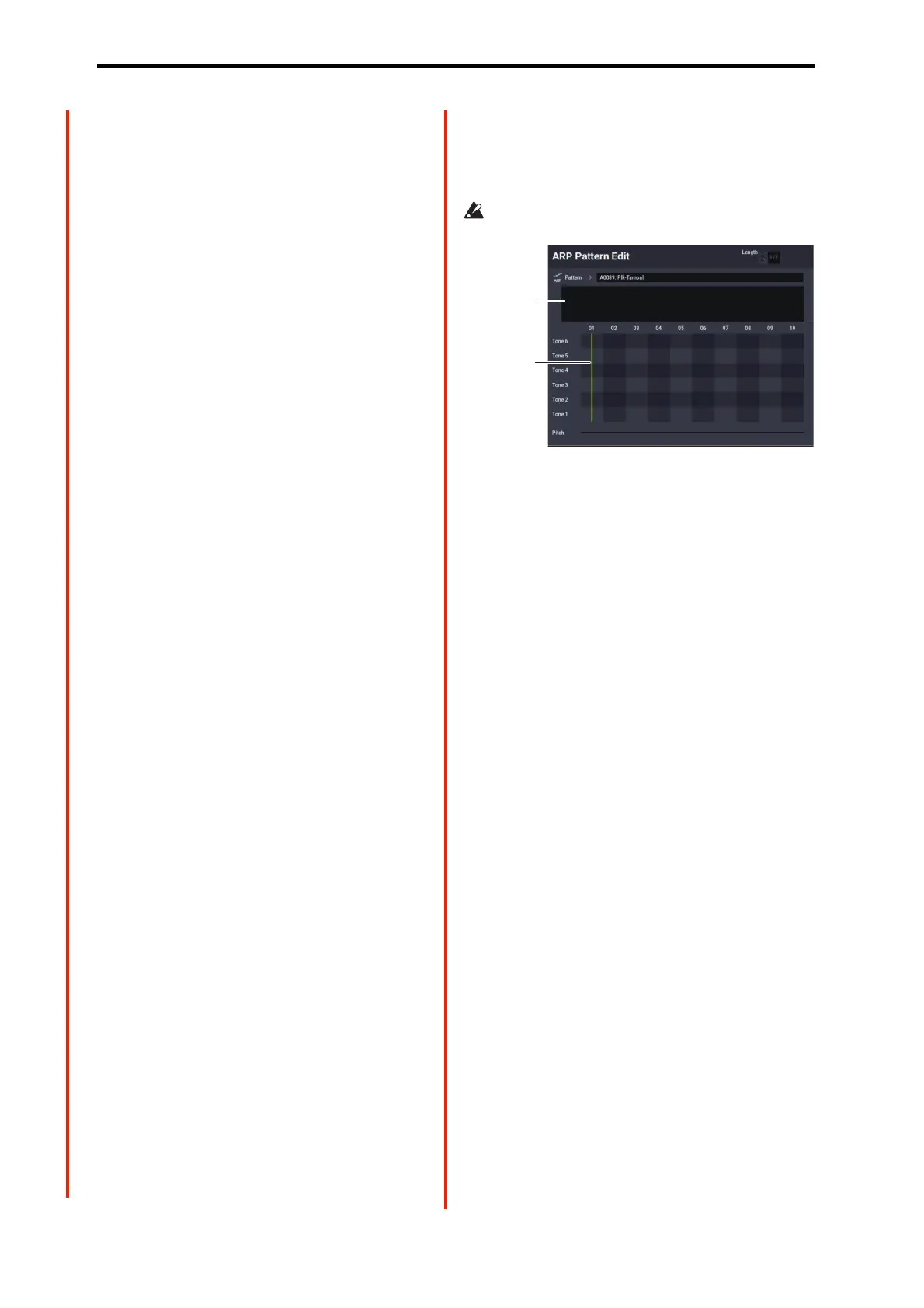GLOBAL mode
680
Running Up: If there are more Tones in a step than arpeggio
notes specified (notes played on the keyboard), the arpeggio
will return to the first note (if Sort is Off), or the lowest note
(if Sort is On) and sound it.
Up&Down: If there are more Tones in a step than arpeggio
notes specified (notes played on the keyboard), the arpeggio
will return in reverse direction from the last arpeggio note
back toward the first.
Example)
If you set Length to 04, Step No. 01 to Tone0, Step No.
02 to Tone1, Step No. 03 to Tone2, Step No. 04 to Tone3,
and simultaneously play three notes to produce an
arpeggio, the following results will be produced
depending on the Arpeggio Type.
As Played:
0
→
1
→
2
→
rest
→
0
→
1
→
2
→
rest
→
0 ...
As Played (Fill):
0
→
1
→
2
→
2
→
0
→
1
→
2
→
2
→
0 ...
Running Up: 0 → 1 → 2 → 0 → 0 → 1 → 2 → 0 → 0 ...
Up&Down: 0 → 1 → 2 → 1 → 0 → 1 → 2 → 1 → 0 ...
Octave Motion [Up, Down, Both, Parallel]
Specifies the operation when Octave is set to 2–4 octaves.
Up: Notes will repeatedly ascend within the specified range
of octaves.
Down: Notes will repeatedly descend within the specified
number of octaves.
Both: Notes will repeatedly ascend and descend within the
specified number of octaves.
Parallel: The notes of the specified octaves will sound
simultaneously.
Fixed Note Mode [Trigger As Played, Trigger All
Ton es]
When the Arpeggio Tone Mode is Fixed Note, specifies the
condition that will trigger the Tones.
Trigger As Played: The Tone s will be triggered according
to the number of keys pressed.
Trigger All Tones: Pressing a single key will trigger all
Tone s .
Steps per Beat [x1, x2, x4]
This sets the steps that will swing. The amount of swing is
set with the “Swing” parameter in the ARP settings of Scene
Setup (found in each Program, Combination or Song), or
with RT control knob 4 (SWING). (When the RT control
knob 4 (SWING) is “+00”, the swing effect is determined by
the value of the “Swing” parameter in Scene settings.)
x1: Swing will be applied to even-numbered steps (2, 4, 6,
8...).
x2: Swing will be applied to steps 3, 7, 11, 15 and numbers
following this pattern. For example, when “Resolution” in
the Scene 1–4 Setup detailed settings dialog box is set to
and you input an eight-beat rhythm, you’ll get an eight-beat
swing effect.
x4: Swing will be applied to steps 5, 13, 21, 29 and numbers
following this pattern. For example, when “Resolution” in
the Scene 1–4 Setup detailed settings dialog box is set to
and you input an eight-beat rhythm, you’ll get an eight-beat
swing effect.
Setup Fixed Note
Opens the Fixed Notes dialog box. Select the notes used
when “Arpeggio Tone Mode” is set to “Fixed Note”.
ARP Pattern Edit
The parameters here will be disabled for preset patterns
P0–P4.
Input Tones 1–12 into steps 01–64. Each “step” can be set up
to a length of 64 steps, and up to 12 notes on the keyboard
can be played simultaneously per step for a Tone. When
“Sort” is selected in the ARP settings of Scene Setup, the
Tones will correspond to Tones 1, 2 and so on in the order of
the notes that were simultaneously pressed (from low to
high). When “Sort” is cleared, the Tones will correspond to
Tones 1, 2 in the order that they are pressed.
Touch View
Selects the display area of the Touch Grid.
Touch Grid
Tone Panel
Insert or delete tones by pressing somewhere on the Tone
Panel (upper part of the matrix).
Meter [1/4...16/16]
Specifies the beat (time signature) of the arpeggiator pattern.
Step (Step Number) [01...48]
Select the step that you want to edit.
Pitch (Pitch Offset) [–48...+48]
Shifts the pitch of the scale up or down in semitones,
corresponding to the Tone for each step. This lets you
specify the same Tone for each step and play melodies, or
specify multiple Tones for the same step to play parallel
chords.
Gate [Off, 001...100%, Legato]
Off: The step in question will not sound, even when a Tone
is set. Use this to stop legato parts that sound in previous
steps.
Legato: Either the same Tone will be the next to be played
(including Gate:Off), or the sound will continue to play until
the pattern returns to the beginning.
This setting is enabled when “Gate” in the ARP settings of
Scene Setup (found in each Program, Combination or Song)
is set to “Step”.
When setting this, make sure that the “Gate” of the mode
you are switching from is “Step”.
Touch View
Touch Grid
(Tone Panel)

